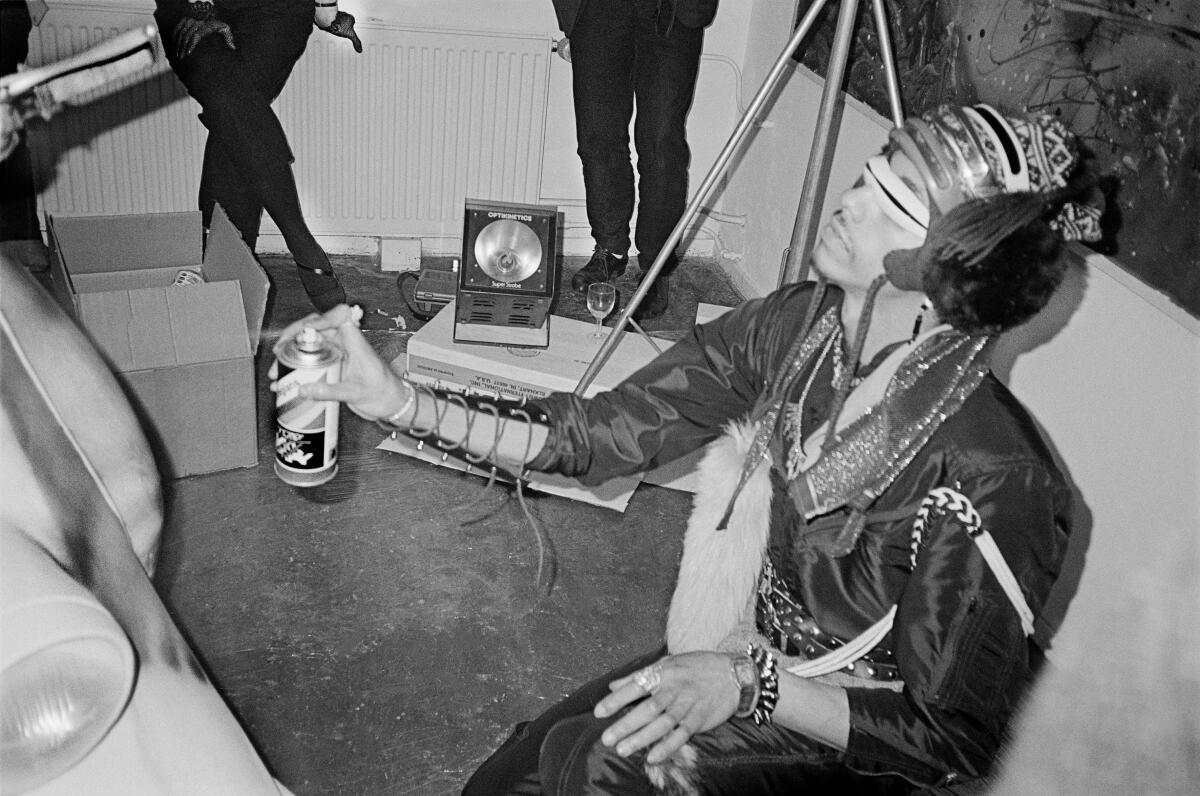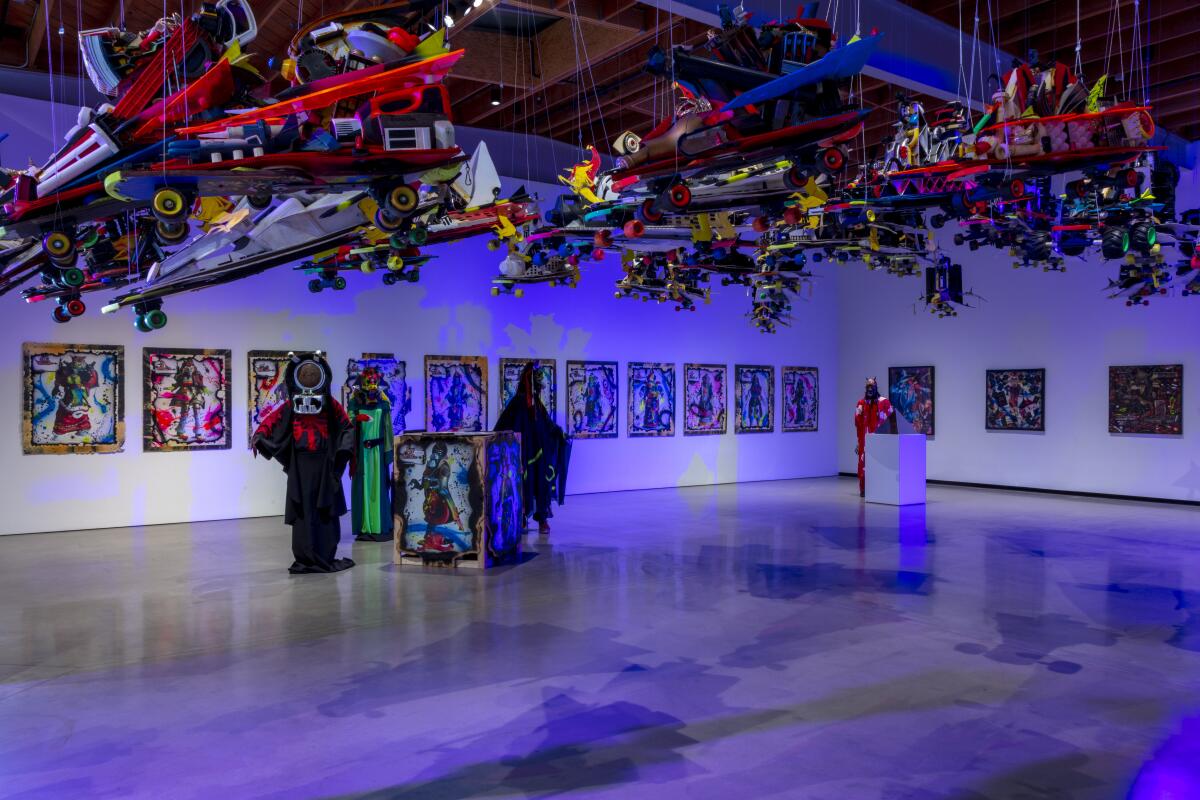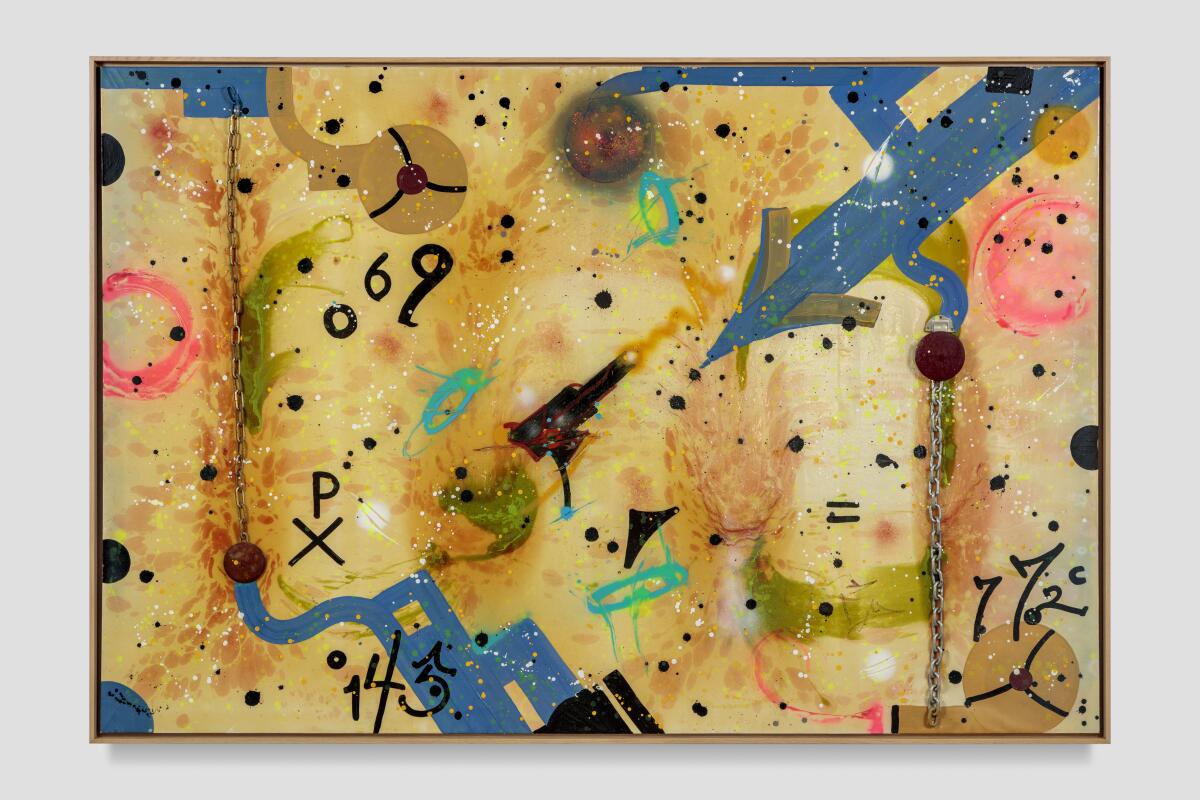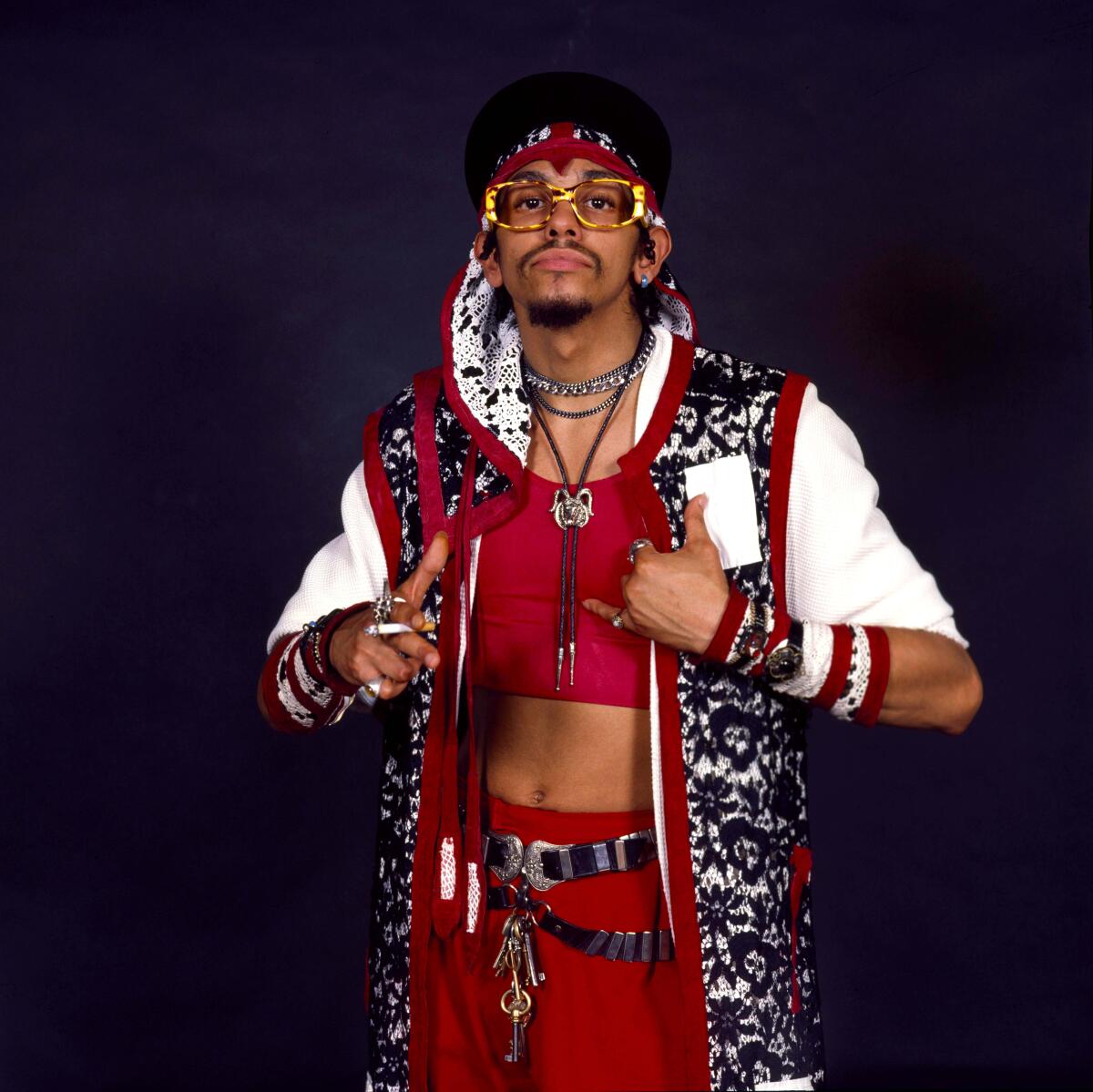Hip-hop iconoclast Rammellzee’s prolific art has long been obscured. That’s starting to change

In the early 1980s, New York artist Rammellzee made two trips to Los Angeles with his friend Jean-Michel Basquiat. The second, in March 1983, inspired Basquiat’s painting “Hollywood Africans,” which resides in the permanent collection of the Whitney Museum of American Art. It immortalizes himself and the artist Toxic with Rammellzee, who is wearing wraparound mirror shades like the Terminator.
The earlier trip, at the close of 1982, produced another compelling artwork: a photo of the duo standing on a Santa Monica Boulevard median taken by Stephen Torton, who worked closely with both men for years as assistant and impresario. “The title of that photograph is ‘Jean-Michel and Rammellzee Exiting Maxfield’s,’” says Torton. They had just visited the clothing store on Melrose and wore the clothes they’d bought. Basquiat, in a mismatched suit, has his hands in his pockets. Rammellzee, wrapped in a long coat, grins and strikes a pose.
Stylish, streetwise, effortlessly cool and brimming with attitude, the two artists both made a gigantic impact in very different ways. Basquiat through the immense fame that came with his rapid artistic success; Rammellzee as an outsize influence on the hip-hop culture he helped birth. For decades, Rammellzee’s prolific and utterly unique body of work has been occluded. That is starting to change.
Rammellzee gave his vision a name, Gothic Futurism, which lends itself to the title of a large retrospective at Jeffrey Deitch Gallery (running until Jan. 14) and returns him to West Hollywood 12 years after his death, at age 49, in 2010. The works in the show, including more than 60 paintings on canvas, cardboard, wood and even carpet — some in three dimensions or coated with resin, dense with information, overlaid with texts and swirls of spray paint.

“I’m convinced,” says Jeffrey Deitch, who also represents the artist’s estate, “that if you hang one of these works of Rammellzee next to a Jackson Pollock, a Kandinsky, one of the great modern, abstract painters, it can stand up.”
The show’s centerpieces are 21 Garbage Gods, elaborate, lifesize, full-body costumes meticulously crafted from the detritus of modern life. Max Wolf, former director of Red Bull Gallery in New York, who curated an extensive retrospective, “Rammellzee: Racing for Thunder,” there in 2018, describes the costumes as “far more ceremonial objects than objects of art.”
Built as living sculptures, made to be worn by Rammellzee during his performances as an MC, each had its own personality, mannerisms and mode of movement. The Garbage Gods inhabited him as much as he inhabited them. This cast of superheroes and supervillains populated a sprawling cosmic space opera of his own devising. These he also made into miniature maquettes as proof of concepts for potential action figures.

To meet Rammellzee in person was to immediately fall under the influence of a charisma that held you in its grip, while he relayed a dizzying stew of information — philosophical, historical, cultural, but never personal — in an argot all his own.
By his own account, he first started graffitiing trains at age 9, stealing keys from his father, a New York City Transit cop, at his Far Rockaway, Queens, home to gain access to the train yards at night. By 19, he had officially retired from that activity, even sending a letter of “resignation” to the Transit Authority, and was enrolled in a program for high school dropouts at the Fashion Institute of Technology in Manhattan, executing complex works in marker on board.
At some point, he became involved with Five-Percent Nation, the New York offshoot of the Nation of Islam, and began calling himself Rammellzee. Not a name, as he would take pains to explain, but an equation — RAM times elevation to the power of Z — and “military function formation” that he embodied. His early battles with authorities to attempt to write on trains became folded into an epic narrative of an eternal war between the keepers of knowledge and language, and those who sought to hide and destroy it. He gave this art movement, his personal art movement, an appropriately warlike name: Ikonoklast Panzerism.
An all-rounder in the early hip-hop scene, Rammellzee was an honorary member of legendary b-boy group Rock Steady Crew and likely the first Five Percenter to rock the mic. He was captured during the closing concert filmed for the seminal hip-hop movie “Wild Style,” at the East River Amphitheater in October 1981, wearing a trench coat and holding a mic in one hand and a shotgun in the other. The weapon was plastic, says Torton, but he swung it around while rapping as if it was real. “The entire audience thought he was about to open fire.”

Nick Taylor, who played in Basquiat’s noise-rock group, Grey, and was a friend to both artists, recalls Rammellzee’s visits to Basquiat’s loft-studio. “We would listen to Ramm’s incredible, far-out ideas and look at each other in complete amazement,” he says.
In 1983, Basquiat produced a 10-minute hip-hop record called “Beat Bop,” a street corner narrative in which Rammellzee emerges as the first signifying rapper, adopting multiple voices and personas. The tune has been heavily sampled, most notably by the Beastie Boys and Cypress Hill. DJ Muggs of Cypress Hill, who moved from Queens, N.Y., to East L.A. at age 9, recalls listening to the record. “Everybody was kind of disco-ed out at the time,” he says. “People wasn’t talking about sniffing cocaine and having a gun and smoking weed … this was like psychedelic s—.”
The break between Rammellzee and Basquiat came, says Suzanne Mallouk, Basquiat’s long-term girlfriend, because “Rammellzee felt that Jean’s newfound success should be shared with other artists of color and that he should try to open the doors for them.” Rammellzee would later dismiss Basquiat’s work as “scribble scrabble.”
Through the ’90s and aughts, Rammellzee largely retreated from public view and disengaged from the art world. He toiled in isolation in a second-floor walk-up loft space in Tribeca, N.Y., called the Battle Station, which was painstakingly re-created after his death in collaboration with his late wife, Carmela Zagari, as part of Art in the Streets, the major survey of street art Deitch curated during his tenure at L.A.’s Museum of Contemporary Art.

“He was never a warm, fuzzy artist,” says Deitch, who attempted to stage a show with Rammellzee a few years before his passing but was stymied by his insistence on pouring toxic resin to prepare the works in situ at the gallery. “He always had an edge, there was a toughness and aggression, and that’s very much part of the work.”
There’s a sense that as much as he wanted the work to be seen, iconoclast to the end, Rammellzee was determined to protect it until he was no longer of this earth. A sign hung on the door of the Battle Station read, “He Who Dies With the Most Toys Wins.” Rammellzee certainly did. Those toys have now been gifted to the world to play with.
'Rammellzee: Gothic Futurism'
Where: Jeffrey Deitch Gallery, 925 N. Orange Drive, Los Angeles
When: 11 a.m.-6 p.m. Tuesdays-Saturdays. Closed Sundays and Mondays. Through Jan. 14.
Info: (323) 925-3000, deitch.com/los-angeles/exhibitions
More to Read
The biggest entertainment stories
Get our big stories about Hollywood, film, television, music, arts, culture and more right in your inbox as soon as they publish.
You may occasionally receive promotional content from the Los Angeles Times.










